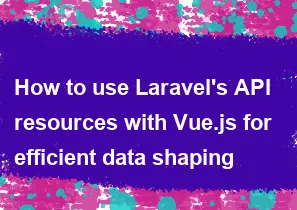How to use Laravel's API resources with Vue.js for efficient data shaping

Using Laravel's API resources with Vue.js can help you efficiently shape and consume data in your web applications. Laravel API resources allow you to transform your Eloquent models and database results into a format that is suitable for your API responses. Here's a step-by-step guide on how to use Laravel's API resources with Vue.js for efficient data shaping:
Step 1: Set Up Your Laravel API Resource
1.1. Create a new API resource using the artisan command:
bashphp artisan make:resource MyResource
1.2. Open the generated resource file (MyResource.php) in the app/Http/Resources directory. Define how you want to shape the data in the toArray method.
Example:
php// MyResource.php
namespace App\Http\Resources;
use Illuminate\Http\Resources\Json\JsonResource;
class MyResource extends JsonResource
{
public function toArray($request)
{
return [
'id' => $this->id,
'name' => $this->name,
// Add other fields as needed
];
}
}
Step 2: Use the API Resource in Your Controller
2.1. In your controller, use the API resource to transform your data before sending it as a JSON response.
Example:
php// MyController.php
use App\Http\Resources\MyResource;
public function index()
{
$data = MyModel::all(); // Replace with your actual Eloquent query
return MyResource::collection($data);
}
Step 3: Consume the API in Vue.js
3.1. Make an HTTP request to your Laravel API endpoint from your Vue.js component using a library like Axios.
bashnpm install axios
3.2. In your Vue component:
javascript// MyComponent.vue
<template>
<div>
<ul>
<li v-for="item in items" :key="item.id">{{ item.name }}</li>
</ul>
</div>
</template>
<script>
import axios from 'axios';
export default {
data() {
return {
items: [],
};
},
mounted() {
this.fetchData();
},
methods: {
fetchData() {
axios.get('/api/my-endpoint')
.then(response => {
this.items = response.data.data;
})
.catch(error => {
console.error('Error fetching data:', error);
});
},
},
};
</script>
Replace /api/my-endpoint with the actual endpoint of your Laravel API.
Step 4: Use the Shaped Data in Your Vue Component
4.1. The data fetched from the API will now be in the format specified by your Laravel API resource.
4.2. Use the transformed data in your Vue.js component as needed.
This approach helps keep your frontend and backend logic separated, making it easier to maintain and scale your application. Laravel API resources provide a clean way to shape your data on the server side before sending it to the client. This separation also allows you to change the data format on the server without affecting the frontend components.
-
Popular Post
- How to optimize for Google's About This Result feature for local businesses
- How to implement multi-language support in an Express.js application
- How to handle and optimize for changes in mobile search behavior
- How to handle CORS in a Node.js application
- How to use Vue.js with a UI framework (e.g., Vuetify, Element UI)
- How to configure Laravel Telescope for monitoring and profiling API requests
- How to create a command-line tool using the Commander.js library in Node.js
- How to implement code splitting in a React.js application
- How to use the AWS SDK for Node.js to interact with various AWS services
- How to use the Node.js Stream API for efficient data processing
- How to implement a cookie parser middleware in Node.js
- How to implement WebSockets for real-time communication in React
-
Latest Post
- How to implement a dynamic form with dynamic field styling based on user input in Next.js
- How to create a custom hook for handling user interactions with the browser's device motion in Next.js
- How to create a custom hook for handling user interactions with the browser's battery status in Next.js
- How to implement a dynamic form with dynamic field visibility based on user input in Next.js
- How to implement a dynamic form with real-time collaboration features in Next.js
- How to create a custom hook for handling user interactions with the browser's media devices in Next.js
- How to use the useSWRInfinite hook for paginating data with a custom loading indicator in Next.js
- How to create a custom hook for handling user interactions with the browser's network status in Next.js
- How to create a custom hook for handling user interactions with the browser's location in Next.js
- How to implement a dynamic form with multi-language support in Next.js
- How to create a custom hook for handling user interactions with the browser's ambient light sensor in Next.js
- How to use the useHover hook for creating interactive image zoom effects in Next.js